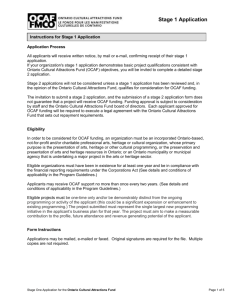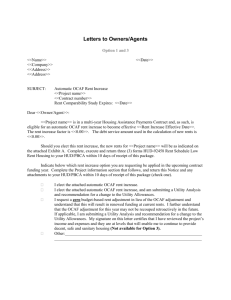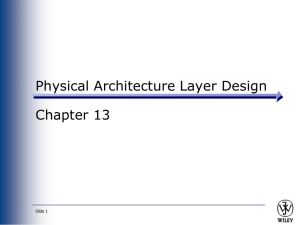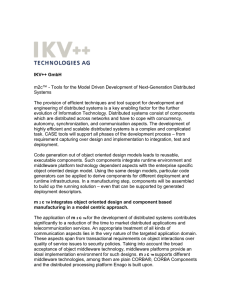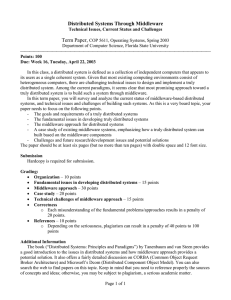O C A F
advertisement
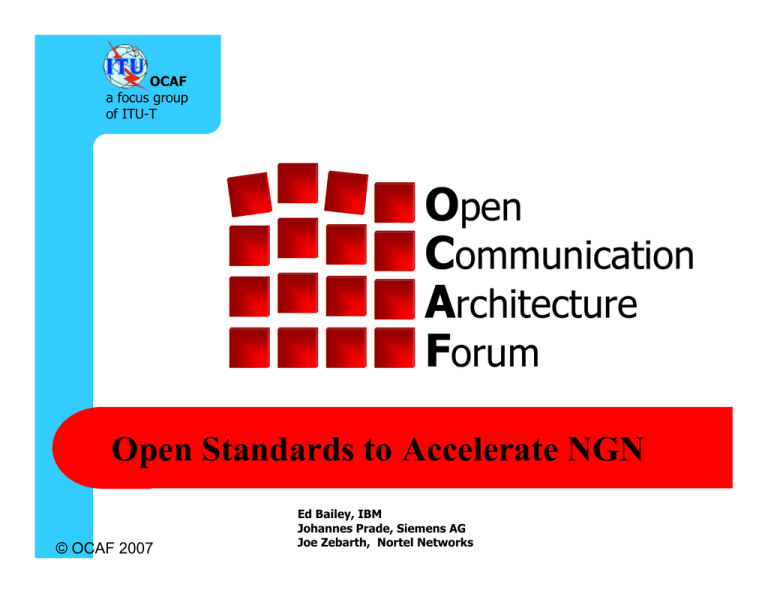
OCAF a focus group of ITU-T Open Communication Architecture Forum Open Standards to Accelerate NGN © OCAF 2007 Ed Bailey, IBM Johannes Prade, Siemens AG Joe Zebarth, Nortel Networks page 1 Topics What is OCAF and Why is it Important? What has OCAF Accomplished so far? Where is OCAF Going? page 2 © OCAF 2007 02/28/07 Open Communication Architecture Forum (OCAF) – ITU-T SG 13 Focus Group NGN Telecom Solution Development Model … A AAp A AAApp pppp Ppppp p P A AAp A AAApp pppp Ppppp p P A AAp A AAApp pppp Ppppp p P A AAp A AAApp pppp Ppppp p P The Open Communications Architecture Forum consists of industry leaders working to accelerate the cost benefits derived from adopting COTS technologies by Defining an NGN Application Platform MW SW HW Why is OCAF important? • OCAF is working to establish an agreedupon list of standards for carrier grade open platforms. The Carrier Grade Open Environment (CGOE) is accelerating the adoption of NGN platforms and services. Founding Members: Avaya, Cisco, Comcast, Deutsche Telekom, France Telecom, IBM, Lucent, Nortel Networks, NTT, Siemens, and Telecom Italia How will OCAF benefit me? • Enables COTS component ecosystem • Reduces cost and time to market • Enables NEPs and SPs to quickly launch new products for both wireless and wireline • Enables mixing and matching of solutions from different solution providers http://www.itu.int/ITU-T/ocaf/ page 3 © OCAF 2007 02/28/07 Value to Industry • OCAF advances use of open publicly available standards • OCAF accelerates the composition of new services • OCAF increases entry point opportunities for new participants • OCAF eases the integration of multiple solutions • OCAF improves and clarifies market segmentation page 4 © OCAF 2007 02/28/07 Key Milestones OCAF established as industry consortium: March 2004 OCAF announced as ITU-T focus group: July 2004 OCAF published CGOE reference model: May 2005 ITU-T Question Q.16/13 approved: July 2006 ITU-T Recommendations approved: March 2007 Y.2901 CGOE Framework Y.2902 CGOE Components page 5 © OCAF 2007 02/28/07 OCAF a focus group of ITU-T Open Communication Architecture Forum Accomplishments page 6 © OCAF 2007 CGOE reference model The CGOE reference model promotes the use of a set of standards, which form the framework - on top of which new applications, e.g. NGN applications can be built - which can be populated with “real” products. In order to achieve this, it is necessary to define a) what are the required functions b) what are the identified standards (or missing standards) and “CGOE categories” organize the functions and standards within the model in respect to one another. page 7 © OCAF 2007 02/28/07 Carrier Grade Open Environment (CGOE) Reference Model Network NGN Applications Applications Management OAM&P OAM&P Appl Services appl.services Protocol Appl Services Services Signaling Gateway Gateway Signaling Protocol Protocol Stacks Stacks Interface & OAM&P Service Middleware Proxies -- Industry Specific Basic Telecom Network Portal Appl appl.services Services Services Database OAM&P Middleware Middleware Interface & Database Service Middleware Proxies J2EE / Web Services Middleware Middleware Operating Platform Workload Workload Remote API System Model Data Model Platform Event Java Mgmt Services Services Mgmt Services Services Services Services Services High Availability Services Cluster Messaging Services Security Infrastructure Infrastructure & & Services Services Security Industry Application Technology Usage Base IP Communications Standard & Embedded OS Server Hardware Industry Agnostic ATM, Ethernet, RAID, SCSI, … Network, storage, rack servers, blade servers, … page 8 © OCAF 2007 02/28/07 CGOE components A CGOE component is a unit of measure, - which provides a well defined function - with standardized interface and/or behavior Examples: +) SQL Database: - database would be the function, - SQL the interface, => is a CGOE component - “SQL” the standard -) HA middleware: - HA is not a function - SAF would be the standard - many different interfaces => not a CGOE component Note: A CGOE component is not necessarily the unit of a realized COTS product. Such a product may contain more than one “CGOE component”. page 9 © OCAF 2007 02/28/07 CGOE Components Initially Identified by OCAF Carrier Grade Open Environment Component Category Carrier Grade Open Environment (ctd.) CGOE Component Component Category Protocol Services Diameter Availability Middleware Start up/Recovery Protocol Services GUP Protocol Availability Middleware Alarm Management Protocol Services GUP Server System Model Services SW Upgrade Protocol Services I-CSCF System Model Services Patching Protocol Services P-CSCF System Model Services Life Cycle Manager Protocol Services S-CSCF Availability Middleware HW Resource Manager Signaling Protocol Stacks SIP Availability Middleware SW Resource Manager Signaling Protocol Stacks SIP Proxy Availability Middleware Diagnosis Protocol Services COPS Platform Event Services Trace Base IP Communications SNMP Workload Management Overload Control Base IP Communication http Workload Management Load Balancer Base IP Communication NTP Workload Management Performance Monitoring Base IP Communication FTP Platform Event Services Event Management Base IP Communication TLS Platform Event Services Log Management Base IP Communication IPSec OAM&P Middleware OAM&P Middleware System Model Services Policy Manager Database Middleware Database Middleware Security “Security” Data Model Services Data Model to be determined Accounting Data Collector System Model Services Configuration Manager System Model Services System Model Availability Middleware Availability Manager Basic Network Application Services Basic Network Application Services CGOE Component Subscriber Profile Management Legal Interception/ CALEA to be determined License Management to be determined Application Server (J2EE) page 10 © OCAF 2007 02/28/07 OCAF a focus group of ITU-T Open Communication Architecture Forum Future Goals page 11 © OCAF 2007 Driving OCAF Forward • Ensuring consistency of framework requires • Aligning independent investigation paths • Achieving acceptance of model • Promoting interfaces and standards requires Formalization of the OCAF results Involvement of SW technology providers page 12 © OCAF 2007 02/28/07 Formalization of the OCAF results OCAF will: continue to focus on new items, e.g.: • new components • conformance work with external parties to add value to the documents it produces and documents produced in other fora continue to submit its outputs, in the form of new draft Recommendations into ITU-T SG 13 continue to use its focus group status to gain the benefit of knowledge and experience from non-ITU-T members page 13 © OCAF 2007 02/28/07 Involvement of SW technology providers ISV ISV ISV ISV O pen C ommunication A rchitecture F orum CGOE page 14 © OCAF 2007 02/28/07 Call for ISV participation Proactive role in reducing TTM for your products Influence component definitions for your area of expertise Focus on issues important to your business Work with your customers and your customer’s customer Industry recognition as thought-leader Drive standards without getting buried in them Early access to all work of OCAF and SG-13 Head start on being OCAF compliant for your components Short duration of effort (up to 3 months) Minimal investment (no membership fees) OCAF positioned to make a difference for your business © OCAF 2007 page 15 02/28/07 OCAF a focus group of ITU-T Open Communication Architecture Forum Summary page 16 © OCAF 2007 Summary OCAF is making great progress and has significant participation OCAF is Open and Platform Neutral – all can participate OCAF is a rallying point for NGN COTS Suppliers and Consumers OCAF Future Work Needed: Extension of set of CGOE components Look towards addressing conformance page 17 © OCAF 2007 02/28/07 OCAF a focus group of ITU-T Open Communication Architecture Forum Thank You page 18 © OCAF 2007
